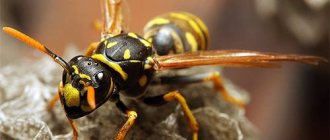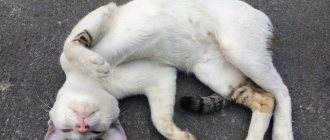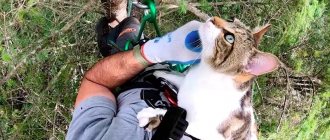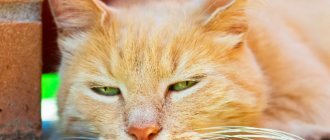During the warm summer months, trees, plants and flowers bloom, birds sing, and our cats spend more time outdoors. Local wildlife is at its peak as summer takes advantage of all the fruit on offer. Unfortunately, this is the time when insect bites most affect both us and our pets. Bees and wasps are a common cause of insect bites in cats. In general, bees and wasps do not bite unless provoked. Cats can be "accidentally" stung if they touch, step on, or kick wasps and bees.
Bees and wasps are known to be venomous insects that inject venom into an unsuspecting victim when they bite. When a venom is injected into an animal, it can cause local tissue reactions or a whole body reaction in allergic or sensitive cats. More adventurous or inquisitive cats, such as kittens, may be more likely to suffer from wasp and bee stings as they are more likely to explore or try to catch these insects. Cats have a strong prey drive, which makes them more likely to be stung by wasps or bees than other species.
Signs that your cat has been stung by a bee or wasp
If you've ever been stung by a bee or wasp, you'll understand that it can be painful and irritating. Bee venom is acidic with a pH of 5.0 to 5.5 and is therefore very irritating to the affected tissue. Wasp venom is closer to neutral at a pH of about 6.8-6.9. Nonallergic reactions usually develop within a few hours, but severe allergic reactions (anaphylaxis) tend to occur more quickly and often within one hour of a cat being stung by a bee or wasp. The consequences of a bee or wasp sting will depend on where your cat was stung, how many stings she received, and whether she has been stung before. Cats are very good at hiding pain or discomfort, but some of the symptoms they will show if they are stung by a bee or wasp are listed below:
© shutterstock
- By unexpectedly nipping or licking a body part - you may have noticed that they were playing with a wasp or bee in the garden a few minutes before.
- Swelling, redness, itching and local irritation - at the site of a bee or wasp sting. Cats are usually stung on the paw, face or nose. In long-haired cats, these skin changes may be more difficult to detect.
- Pain – Your cat may vocalize more frequently than usual.
- Cats that may have a bee sting in their mouth or a wasp sting in their nose may paw at the area due to discomfort .
- Urticaria is an allergic skin pattern characterized by multiple swellings throughout the body.
- Trouble breathing or difficulty swallowing – If your cat is stung by a bee or wasp on the face or in the mouth, such as the tongue, it may cause swelling of the face, mouth and/or neck.
- Drooling, vomiting, diarrhea, rapid breathing, difficulty breathing, pale gums (shock), and collapse may occur if your cat develops anaphylaxis as a result of a wasp or bee sting. This happens more often with cats that have been stung before.
Treatment
There are no special cat medications available for the treatment of insect bites, so people turn to traditional medications for help. The pet’s body’s reaction to the wasp toxin varies: from a small swelling to an anaphylactic shock state.
If there are signs of the latter, immediate hospitalization of the cat is required. A weak inflammatory focus can be stopped with improvised drugs from the first aid kit or at home.
Pills
Often, animal owners, when symptoms of damage appear, use homeopathic Apis tablets, in a dosage of two or three pieces. They quickly remove the risk of developing a further allergic reaction. If your pet has previously suffered from severe forms of allergies, you should always have this medication at home.
It is advisable to use corticosteroids. This series of drugs is prescribed by a doctor and refers to hormonal anti-inflammatory medications. Experienced cat breeders use Prednisolone in the form of pills, at a rate of 0.5 - 1 mg of the drug per kilogram of animal weight.
Ointments
To treat minor inflammation of soft tissues in cats, products based on medicinal herbs are used in the form of creams. They use the time-tested Zvezdochka, Bepanten, Menovazin. For symptoms of moderate severity, therapy with Fenistil gel is carried out. When the initial period of development of the disease has been missed, the clinical picture has acquired pronounced features, then the cat needs antiallergic ointments of deeper penetration: Triaccutane, Elokom, Advantan and Betamethasone.
In case of aggravating factors, in the form of a developed infectious focus, your cat requires a local antibiotic; the drugs most often used are Tetracycline, Gentamicin, Levomekol or Erythromycin.
Skin inflamed by a bee sting should be treated 1 to 4 times a day. As the disease disappears, the dosage is reduced. Treatments last 5-6 days. When the bite is on the body, paw or tail, and the cat’s well-being has not worsened, such therapy will be sufficient.
If a cat was bitten by a wasp, and after 2 days the pet’s health has not improved, it is recommended to show the animal to a veterinarian.
Treating an allergic reaction with potent drugs without consulting a qualified specialist is extremely risky. If the dosage is selected incorrectly, they can reduce weak immunity and lead to the recurrence of the disease in the infectious plane. If it is not possible to take the injured cat to a medical center, you can consult a doctor by phone and carry out treatment yourself.
Therapy with Dexamethasone, Prednisolone, and Diazolin is usually recommended. In cases where a bee has bitten a kitten, Benadryl is used. The widespread Suprastin is not a universal enough medicine and does not find an immune response in all cats.
Folk remedies
Many owners prefer traditional medicines to pharmaceutical ones, due to their complete safety and ability to use in unlimited quantities. Their effectiveness is not as high as drug therapy, but is still beneficial. Use the following tips:
- A piece of citrus fruit or apple applied to vinegar relieves irritation;
- Treat the area with soapy water, tincture of chamomile, sea buckthorn, and calendula, which have a calming effect;
- Turmeric diluted with water helps relieve inflammation;
- An oatmeal bath can eliminate itching and pain in your pet;
- Citric acid diluted with water relieves swelling well.
When a bee bites your cat on the body or paw, this type of therapy should be sufficient. Despite the abundance of different treatment options invented by traditional healers, if your pet gets worse, it is better to seek help from a qualified specialist.
Are bee or wasp stings harmful to cats?
In most cases, a bee or wasp sting is not life-threatening to your cat. However, they can be very irritating and distressing to your pet, and if stung in certain areas or multiple times, it can lead to more severe symptoms.
Cats that are stung and develop severe swelling in the mouth and neck may have a narrowing of the airways. If your cat has been stung by a bee or wasp and is struggling to breathe, then this is an emergency and you should contact your veterinarian immediately.
Bites to the paws can cause pain when walking and may cause your cat to limp. It may take a few days for the lameness to go away as the swelling subsides.
When is it necessary to urgently contact a veterinarian?
If your pet is bitten in the face or mouth, you should immediately show your pet to a doctor. This must be done even if there is no strong redness upon visual inspection. Such damage can cause swelling of the larynx, leading to difficulty breathing and suffocation.
Other cases where assistance from a qualified professional may be required:
- with several bites at the same time;
- in the case where a small kitten was injured;
- if the sting gets into the eye.
Can cats have allergic reactions to bee and wasp stings?
Cats stung by bees or wasps can develop severe and life-threatening reactions if they are allergic to the insect venom. This reaction is most often seen in cats that have been stung previously. This is the result of the cat becoming “sensitized” to the bite and the immune system overreacting the second time around. Anaphylaxis is an emergency and can be fatal if your cat does not receive prompt veterinary treatment, which usually includes supplemental oxygen, an IV, and medications such as epinephrine, steroids, and antihistamines.
Prevention
It is almost impossible to completely protect your cat from being bitten, but when he spends the summer season outdoors, the possibility of insect damage should be minimized. For this:
- The windows are covered with mosquito nets, the doors are hung with curtains;
- Periodically inspect the territory, destroy existing bee nests;
- Treat pets with repellents.
It is not recommended to feed cats outside; here it is much easier for insects to get into the food, and accordingly the risk of being struck by a wasp is much greater.
What to do
- Examine your pet - find out how many times your cat has been stung and where she was stung, such as the nose, mouth, face, paw or body. Beware, your cat may be in pain and may try to bite or scratch you. Check your pet for signs of anaphylaxis.
- Remove the stinger - If your cat was stung by a bee, the stinger may still be in the skin. Stings left in the skin can cause further release of venom, so a bee sting must be removed immediately. The best way to remove the stinger is to use a bank card or something similar. The card is stroked along the edge, carefully over the pet's fur to remove the sting. If you are unable to remove the sting with a card, tweezers can be used, but this may cause further release of toxins if the sting is squeezed. It is not necessary to remove wasp stings.
- Watch for an allergic reaction - this reaction usually occurs fairly quickly after the bite, usually within one hour. If your cat is unconscious or has trouble breathing, contact your veterinarian immediately as she will need emergency care.
- Call your veterinarian if your pet is bitten on the face, mouth, or throat, or multiple times —urgent care is needed for bites to the face, neck, or mouth, as severe swelling in these areas can make it difficult for your pet to breathe. Your veterinarian may prescribe medications for your pet to reduce swelling, such as steroids and antihistamines. They may also want to monitor your pet for a few hours to make sure the swelling doesn't get worse.
What is first aid?
What to do if a cat is bitten by a bee or wasp? In any case, you will have to provide first aid yourself, and then go to the veterinarian if the need arises.
Help algorithm:
- Place the cat in any cool place and give it complete rest. Be sure to bring it from the street into the house if everything happened in the yard.
- Observe the animal for just a few minutes to rule out symptoms of anaphylactic shock or suffocating edema, when you should rush to the veterinary clinic rather than try to help yourself.
- If you have the homeopathic medicine “Apis” in your home medicine cabinet, it is recommended to give the cat 5-10 drops orally with a small amount of water. This is especially true in cases where there is a history of insect bites and allergies to them - this should always be the case.
- Under control of the general condition, you should begin examining the animal’s body to understand where the insect bite occurred. If edema and swelling are found in the area of the larynx, then immediately take your pet to a specialist. Intubation may be necessary, and this can only be done by a specialist.
- Remember: wasps do not leave stings, only bees leave stings! If a cat has been bitten by a bee, you need to find a place with a protruding sting and carefully pull it out using tweezers. It is important not to flatten it, otherwise the intoxication reaction will intensify. If a wasp stings, you can try to lightly squeeze out the ichor with the remaining poison. But this manipulation is only suitable for the first minutes after an insect attack, because then swelling forms and the hole narrows so much that nothing can be squeezed out. During any manipulations at the site of swelling, the cat must be well secured - this is very painful!
After removing the sting and squeezing out any remaining toxins, the bite site can be treated with the following solutions and substances:
- fruit acids (rub with a piece of lemon, apple, orange, you can add a pulp of the pulp of these fruits);
- vinegar water (9% table or natural apple cider vinegar is mixed with water in a 1:1 ratio, a cotton swab is generously moistened and applied to the bite site. The exception is bites in the mouth or near the mouth);
- citric acid solution (make slightly acidic water, moisten a cotton swab, apply to the bite site);
- a soap solution made from laundry soap relieves itching (soap a cotton swab generously and periodically wash the wound);
- soda solution (dilute a third of a level teaspoon in 100 ml of water, wipe with a cotton swab dipped in the solution);
- ammonia (do not generously lubricate the bite site if it is not on the head - legs, stomach, back...);
- turmeric (sprinkle generously on the bite area, after moistening it with plain water).
Applying cold to the bite site
Take something cold (ice, some kind of product) out of the freezer, wrap it in a thin cotton towel or napkin and apply it for 10 seconds with the same breaks. Cold will sharply narrow the skin capillaries, preventing the spread of poison and increasing swelling. Cold can be applied before treating the bite site with topical solutions, especially if the animal has been injured by a wasp. Then cold is first applied, then local treatment is done.
Home remedies for bee and wasp stings
If the sting is mild, it may be appropriate to treat the bee or wasp sting at home. However, you should exercise caution as the bites are often painful and your cat may lash out. Ice packs can be placed on the bite to reduce the swelling and pain your cat experiences. Be sure to cover the ice packs with a kitchen towel or something similar to prevent your cat from getting frostbite or becoming uncomfortable.
Since bee venom is acidic, adding alkali can help neutralize its effects. Bicarbonate of soda (baking soda) can be diluted with water and applied as a paste to the local area. Chamomile lotion has a similar effect. If these products are not available, applying a small amount of toothpaste to the affected area may also help. Do not use any other alkaline products without first consulting your veterinarian.
Antihistamines such as Benadryl may also be useful in treating bee or wasp stings in pets. However, call your veterinarian first to find out if it is safe for your pet and how much to use, since the dosage for pets is different than the dosage for humans. There are many different antihistamines available on the market, but some ingredients are harmful to pets, so check with your veterinarian first to see if it is safe.
Posted by Christian Adams An American expat living in Metro Manila, Philippines for over a decade, Christian is a lifelong cat lover and the proud father of two rescue cats, Trixie and Chloe. Both girls used to be among the crowds of homeless people who roam the cities and countryside. Three-year-old Trixie was rescued from a litter found under a neighbor's porch, and two-year-old Chloe was brought home by Christian's young son, Henry, who discovered the crying kitten in the parking lot.










